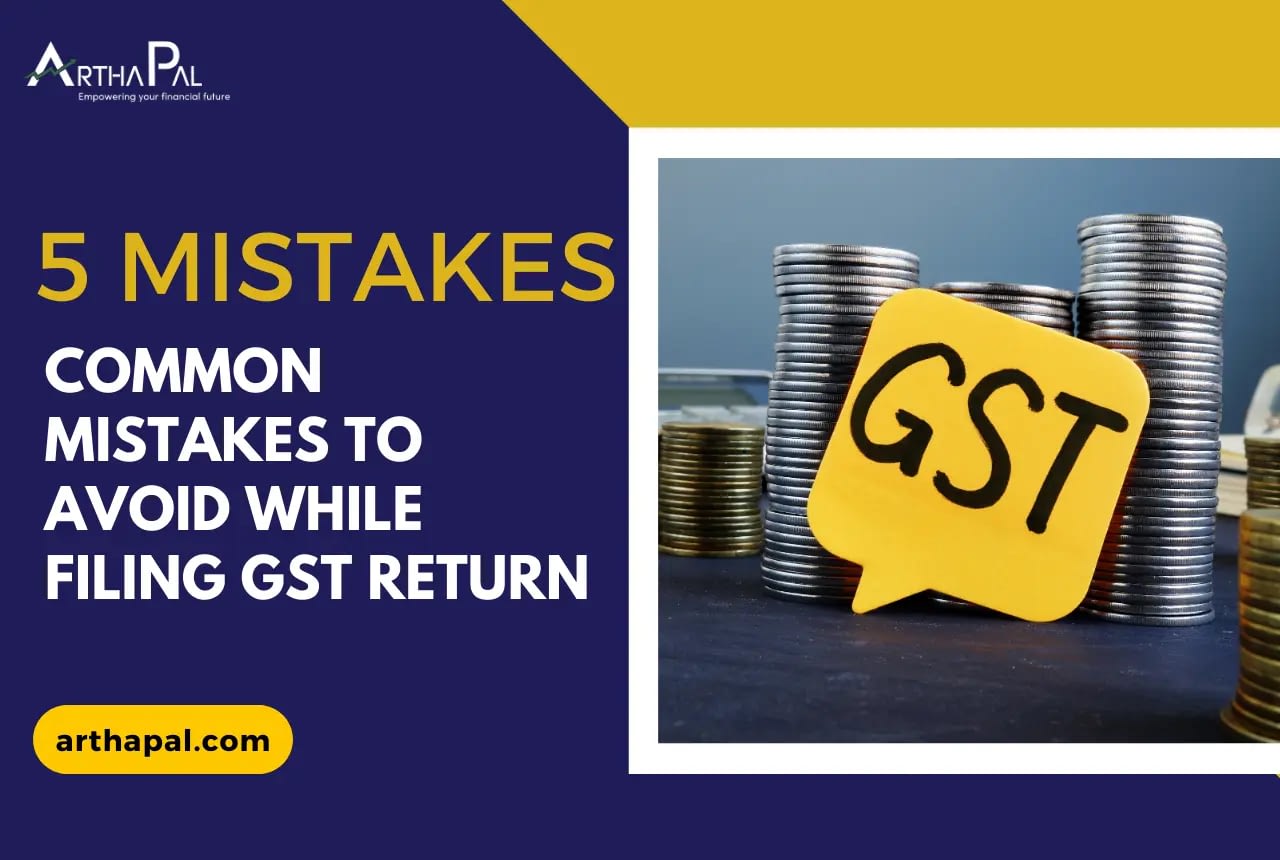There are multiple mistakes to avoid when filing GST return, and how to do it we can learn via the details of this blog. The Goods and Services Tax (GST) is a comprehensive indirect tax levied on the delivery of goods and services throughout India.
It has dramatically altered the tax landscape, requiring firms to comply with its regulations. Accurate and timely GST return filing is critical for maintaining a clean tax compliance record, avoiding legal issues, and guaranteeing smooth business operations.
While filing GST return if one does errors the it could lead to severe consequences, which could affect you a lot like hefty penalties, interest charges, and sometimes even legal actions. If youe want to safeguard your business from these stated repurcussions, it is massively essential to be aware of the common mistakes and employ important preventive measures.
Across the details that’ll be stated in this blog article there will be five highlighted common mistakes that many businesses makes while they are filling their GST returns and will also provide insights that will help you to avoid issues.
By knowing these potential problems and employing effective techniques, you may assure correct and compliant GST return filing, protecting your company’s financial health and reputation.
5 Common Mistakes to Avoid When Filing GST Returns
1. Errors in Tax Classification and Calculation
It is essential to have accurate and if possible to the point tax classification as is the cornerstone of compliant GST returns. If the mistake of misclassification of goods or services happen, they can most potentially lead to incorrect calculations of tax, severe penalties and most probably ceratin legal issues.

Understanding the Importance of HSN Codes
HSN (Harmonised System of Nomenclature) codes are six-digit numbers used to categorise products and services. Correct HSN codes guarantee accurate tax determination. For example, the tax rate on electronic goods varies from that on agricultural products.
Decoding the GST Structure
India has a dual GST system:
- CGST (Central GST): Levied by the central government.
- SGST (State GST): Levied by the state government.
- IGST (Integrated GST): Applicable for interstate transactions.
Understanding when to apply each is crucial. For intra-state supplies, CGST and SGST are levied equally. For inter-state supplies, IGST is levied.
Common Classification Mistakes
- Incorrect HSN Code: Using a wrong HSN code can result in incorrect tax calculation.
- Misclassifying Goods and Services: Treating goods as services or vice versa can lead to significant errors.
- Incorrect Tax Rate Application: Applying the wrong GST rate can result in underpayment or overpayment of tax.
Tips for Accurate Tax Calculation
- Refer to GST Rate Charts: Regularly update yourself with the latest GST rate charts.
- Consult a Tax Professional: For complex scenarios, seek guidance from a tax expert.
- Maintain Detailed Records: Keep thorough records of transactions and supporting documents.
- Utilize GST Software: Many software solutions can assist in accurate tax calculations and filing.
By diligently classifying goods and services and applying the correct tax rates, businesses can significantly reduce the risk of GST-related errors and penalties.
2. Misunderstandings Around NIL and Zero-Rated Supplies
If you want to file accurate GST return then it is crucial to understand the distinct difference between NIL and zero-rated supplies. Both input tax credit (ITC) and return filing involve a zero tax rate, yet there is a significant difference in their implications.

NIL-Rated Supplies
NIL-rated supplies have a zero GST rate but cannot claim an input tax credit for the inputs used in their manufacturing or supply. Examples include food grains, milk, and certain forms of fertiliser.
Zero-Rated Supplies
Zero-rated supplies also have a zero GST rate, but unlike NIL-rated supplies, input tax credit can be claimed on the inputs used in their production or supply. These supplies primarily include exports and supplies to SEZs.
Importance of Correct Categorization
Incorrectly classifying supplies as NIL or zero-rated can lead to significant tax implications. Claiming ITC on NIL-rated supplies is not allowed, resulting in unnecessary tax liabilities. Conversely, not claiming ITC on zero-rated supplies can lead to revenue loss.
To avoid these issues, businesses must maintain detailed records of their supplies and ensure accurate classification.
Government Resources
The GST Council regularly issues notifications and clarifications regarding NIL and zero-rated supplies. It’s essential to stay updated with these notifications to ensure compliance.
By clearly understanding the differences between NIL and zero-rated supplies and adhering to the correct categorization, businesses can streamline their GST compliance and avoid potential penalties.
3. Inaccurate Data Entry and Reconciliation Issues
Manual data entry, a critical component of many businesses, is sadly susceptible to human mistake. In the case of GST returns, these inaccuracies might have serious consequences. Incorrectly inputted data might result in disparities, miscalculations, and, eventually, compliance difficulties.

One of the most crucial locations where these errors occur is during the reconciliation of GSTR-1 (sales) and GSTR-3B (summary) returns. These two returns must be exactly aligned to avoid penalties and interest costs. Any discrepancy can elicit investigation from tax officials.
To reduce data entry errors, firms may consider installing strong data validation tools. These technologies can detect irregularities, such as inaccurate GSTINs, HSN codes, or tax rates. Furthermore, switching to accounting software can simplify the process and eliminate the need for manual intervention.
Effective reconciliation is equally important. Regular checks for anomalies between sales and purchase data can aid in detecting problems early on. Creating precise reports on purchases and sales allows for a more thorough comparison. Furthermore, reconciling data on a regular basis, rather than waiting until the conclusion of the tax season, might make the process less daunting.
Businesses that prioritise data quality and reconciliation can dramatically minimise their risk of GST-related penalties while also ensuring compliance.
Key points:
- Manual data entry is a primary source of errors in GST returns.
- Mismatches between GSTR-1 and GSTR-3B can lead to serious consequences.
- Data validation tools and accounting software can help prevent errors.
- Regular reconciliation of purchase and sales data is essential.
4. Neglecting Reverse Charge Mechanism (RCM) Applicability
The Reverse Charge Mechanism (RCM) is a GST provision in which the recipient of goods or services is required to pay tax rather than the supplier. This approach is intended to bring certain sectors, particularly the unorganized ones, under the tax net.

RCM applies to a variety of scenarios. These include:
- Purchases from unregistered suppliers exceeding a specified threshold.
- Specific services like job work, import of services, goods transport agency services, and more.
- Certain categories of goods like scrap, timber, and more.
Failure to comply with RCM might result in serious repercussions. Incorrectly reported RCM transactions can lead to substantial tax bills, fines, and interest costs. It may also result in complications with input tax credits (ITCs) and potential tax audits.
To ensure accurate RCM compliance, businesses should:
- Clearly understand the services and goods covered under RCM.
- Maintain detailed records of RCM transactions.
- Issue self-invoices to suppliers where necessary.
- Accurately report RCM transactions in GSTR-1 and GSTR-3B.
- Regularly review and reconcile RCM-related data.
By following the mentioned steps and guidelines, a lot of RCM-related pitfalls can be avoided by businesses and could easily maintain GST compliance.
5. Missing Deadlines and Late Filing of Returns
In order to avoid financial penalties and potential legal repurcussions, it becomes really paramount to adhere to GST return filing deadlines. There could be disruption of the smooth flow of input tax credit, which could lead to cash flow issues whenever there is late filing.

GST returns are classified into numerous sorts, each with a different due date. Monthly returns, including GSTR-1 and GSTR-3B, must be submitted on time. Quarterly returns, such as GSTR-4 for composition dealers, have varying deadlines. Missing these deadlines can result in late fees and fines.
Filing a late return requires a special procedure. It usually entails paying a late charge and filing the return with the relevant information. The specific fines vary depending on the length of the delay.
To avoid missing deadlines, businesses can implement effective strategies. Setting up calendar reminders for due dates is crucial. Utilizing GST filing software can automate many processes and provide timely alerts. Maintaining organized financial records also contributes to efficient return filing. By prioritizing timely submissions, businesses can mitigate risks and ensure compliance.
Additional Tips for Smoother GST Return Filing
Aside from the key topics highlighted, a few extra practices can considerably improve the GST return filing procedure.

Keeping precise accounting records is essential. These records should be up to date and conveniently available for use during return preparation. Invoices should be properly organised, both physically and digitally, to ensure smooth data entry. Regularly reconciling bank statements and accounting data can aid in detecting anomalies early on.
It is recommended that enterprises dealing with complex GST systems or suffering regular issues consult with a tax specialist. Their experience can bring useful insights, assist in navigating complex rules, and reduce the chance of errors.
Businesses that use these supplemental steps can expedite their GST compliance activities, minimise the likelihood of errors, and enjoy a more seamless filing experience.
Rewinding
Mistakes in GST returns can lead to significant financial implications, including penalties, interest, and even legal issues. Ensuring accuracy is paramount for businesses to maintain compliance and avoid unnecessary burdens. Meticulous record-keeping, careful calculations, and timely submissions are essential.
For comprehensive guidance, always refer to official GST notifications and circulars. If you encounter complexities or require expert assistance, consider consulting with a tax professional.
Stay updated on GST changes by subscribing to our newsletter. We’ll keep you informed about the latest updates and regulations.


